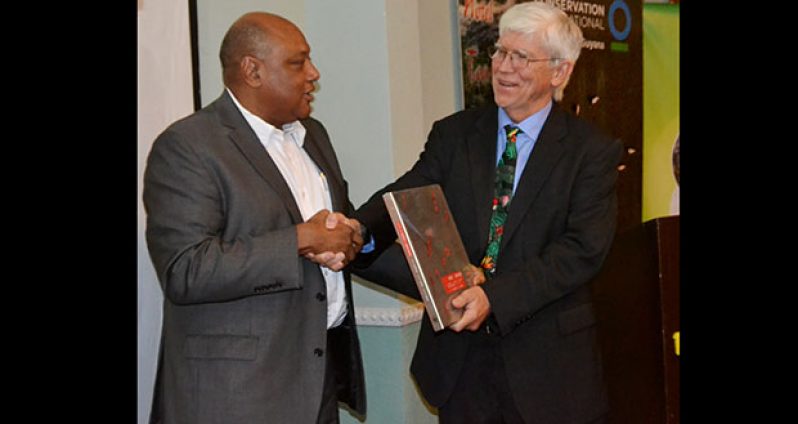By Alva Solomon
GIVEN that it is one of three countries in the world with the highest per capita water availability, Guyana is in a unique position to capitalise on marketing its drinking water to the rest of the Caribbean region.This is according to the President of Conservation International, Dr Russell Mittermeier, who told a gathering of Government officials and conservationists, on Monday evening at the Duke Lodge

in Duke Street, Kingston, that this country’s per capita water rate follows Surname’s and Iceland’s.
He said that water is topical globally, and that “it is increasingly becoming a geo-political issue in many parts of the world”.
He told the gathering, which included Minister of Natural Resources, Raphael Trotman; Minister of Indigenous People’s Affairs, Sydney Allicock; and Minister of Education Dr Rupert Roopnaraine that Guyana is well on its way to achieving its “green economy” mandate, since it already possesses vast natural potential, including the Rupununi Savannahs, which he identified as the most intact savannahs in the Amazonia region.
“This region is unique,” he said, noting that Guyana is the second greenest country on the planet, second only to neighbouring Suriname.
He said the Rupununi Savannah is overlooked sometimes in the “general scheme of things”, but the savannah is equal to the tropical rainforest here.
As regards the coastal region, Dr Mittermeier noted, the country can invest in “Blue Carbon initiatives”, a term which refers to the carbon captured by the world’s oceans and coastal ecosystems.

He said marine systems on a global scale have not received much attention. “You have the potential as a protected area or major protected area,” he noted in that regard, adding that the country is rich in its biodiversity.
As regards the protected areas, he pointed to the Rupununi Savannahs as being one of several areas in the country which can be developed into such areas.
PARIS AGREEMENT
On April 22, President David Granger signed the Paris Agreement at the United Nations headquarters in New York. The agreement, which is within the framework of the United Nations Framework Convention on Climate Change (UNFCCC) dealing with greenhouse gases emissions’ mitigation, adaptation and finance, starting in the year 2020, was identified by Dr Mittermeier as “the best and one of the best that came out of the Paris Convention”.
He said that, by signing the agreement, President Granger effectively placed Guyana in a comfortable position as regards the development of strategies in transitioning to a green economy.
According to Dr Mittermeier, there is need for the creation of protected areas. He noted that it is the “single most important tool” for achieving biodiversity and conservation.
He said that Guyana has the requisite network to add two million hectares of land and waterways for conservation, a commitment made by President Granger when he spoke of the Government’s intention to foster a Green Development Strategy at the opening of GuyExpo 2016 recently.
Guyana can also work along with its neighbours on the continent to conserve its landmass through a process which Dr Mittermeier termed “Transnational conservation”.
To this end, he said, he attended a meeting in French Guiana recently, where he met with representatives from Brazil, Guyana and Suriname.
“We really looked at how very different culturally we are, but how (through) collaboration (and cooperation) we can potentially get the French, because French Guiana is a department of France, (to) come and support initiatives with neighbours,” he noted.
Dr Mittermeier also suggested that Guyana can work towards making several sites, including the Roraima Mountain range, World Heritage sites under the United Nations Educational, Scientific and Cultural Organization (UNESCO) programmes.
KEY PARTNERS
Minister Trotman told the gathering that Guyana is blessed and favoured, with two international pillars in Conservation International and the World Wildlife Fund (WWF).
He described Conservation International as innovative, visionary and results-oriented.
Trotman said that one of the challenges ahead, as regards conservation, is financial sustainability of conservation systems, given both the competitive economy here and the environment.
He noted that the Protected Areas Trust Fund chaired by Major General (ret’d) Joe Singh has already contributed US$3.5M to conservation.
He said that over the next ten years, the Government is committed to raising the Fund to US$10M.
Minister Allicock spoke of the contributions of the Indigenous people to the Guiana Shield.
He said that, in reflecting on the past 50 years, “The first peoples of the Guiana Shield were responsible in large measure for the fact that we can today celebrate at this event”.
He said the Guiana Shield is one of several regions that possess the highest biodiversity in the world, with over 3000 vertebrate species, including 1168 fresh water fish, 269 amphibians, 295 reptiles, 1004 birds, 282 mammals and 13,367 species of vascular plants.
“This is the legacy of our fore bearers of the Guiana Shield,” Allicock said. “The world cannot ignore that fact. We cannot be unmindful of our heritage,” he added.
At Monday evening’s event, Conservational International donated US$100,000 to the Government’s conservation plans. The preservation body called on other organisations to provide similar support, as it foresees this country’s rich, diverse natural potential as being pivotal to her transition to a green economy.




.png)









